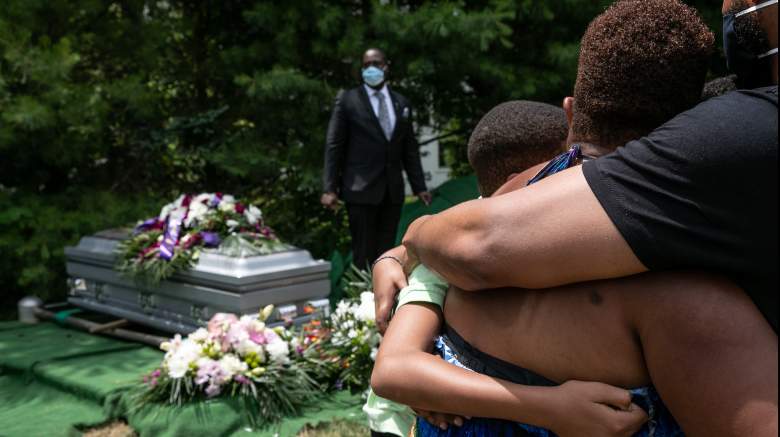
Getty Family members and friends mourn the death of Conrad Coleman Jr. at his burial service on July 03, 2020 in Rye, New York. Coleman, 39, died of Covid-19 on June 20, 2020, just over two months after his father Conrad Coleman Sr. also died of the disease.
For the 10th consecutive week coronavirus deaths have decreased as cases soar in parts of the U.S., according to the Centers for Disease Control. But one epidemiologist says that a possible reason deaths haven’t caught up with cases is due to something called lead time bias — and it has to do with the current influx of early testing.
Ellie Murray, an epidemiologist, assistant professor at Boston University School of Public Health and Associate Editor of the American Journal of Epidemiology, posted her theory in a tweet thread on July 6.
Murray breaks down a theory for the low mortality rate while COVID-19 cases are at an all-time high, calling it “a #tweetorial on lead time bias.”
Lead Time Bias Means a Diagnosis Is Made Sooner so the Duration of an Illness Seems Longer and Death Seems to Come Later
According to Murray, “lead time bias is probably contributing to the lag between cases and deaths.”
The epidemiologist says that essentially, lots of early testing is finding people in the beginning stages of the disease, whereas before the only people who were tested were already very sick and in the later stages of the illness.
Murray explains:
If you have heard of lead time bias, it’s probably in the context of screening programs, like mammograms, colonoscopies, etc. The idea is that when you start actively screening for cancers, you end up diagnosing people *before* they would normally have been diagnosed. That extra (lead) time will make it seem like people who get screened live longer than people who don’t get screened, even if screening changes nothing about how their cancer progresses.
What does this have to do with #COVID19? Well, we switched from only testing people who had really serious severe symptoms to testing a much wider group of people with milder or even no symptoms. Many of the new cases are much earlier in their disease process.
Lead time bias tells us that we can expect to see a longer delay between detection & death because we are detecting people earlier in the disease process. This does not mean people are surviving longer! That’s the sneaky lead time bias talking!!
When you start identifying people at earlier stages of a disease, it looks like they survive longer (or have the disease longer) compared to when you identify based on severe symptoms.
Murray says it’s hard to know for sure what the lag time is between diagnosis and death because there are reporting lags on both test results and causes of death, but “I would be very surprised if it’s longer than 5-6 weeks though,” she says.
In Florida, Texas & Arizona the Death Rate Is Already Climbing
Some of the states with the largest outbreaks are starting to see an increase in deaths from COVID-19. With COVID-19 cases skewing younger, another reason there are less reported deaths so far could be that the virus is not as deadly for younger people overall.
According to the CDC, death certificate data has shown “the percentage of deaths attributed to pneumonia, influenza or COVID-19 (PIC) decreased from 9.0% during week 25 to 5.9% during week 26. … The percentage is currently at the epidemic threshold but will likely change as more death certificates are processed, particularly for recent weeks.”
Dr. Howard Koh agrees. The professor at the Harvard TH Chan School of Public Health told Business Insider that while reported COVID-19 deaths have been lower than in the spring, “No one wants to say too early that deaths are not rising. That would really be a mistake. If somebody is infected and then has the risk of getting sick and being hospitalized and dying — that whole trajectory takes a number of weeks, at least, maybe up to a month or more.”
One model by the Institute for Health Metrics and Evaluation predicts nearly 45,000 more deaths by October 1 if things stay as they are. With universal mask-wearing, the model shows 25,000 fewer deaths during that same time frame.
READ NEXT: Amy Cooper Charged With False Reporting In Racist Incident That Went Viral